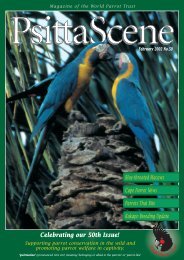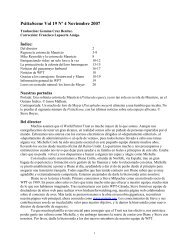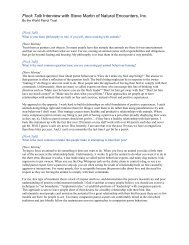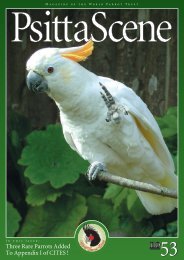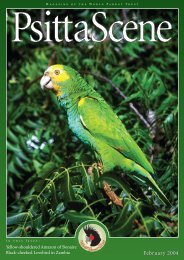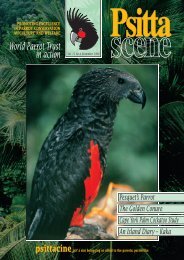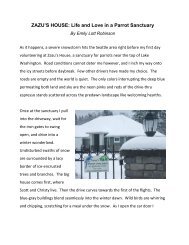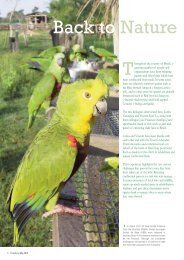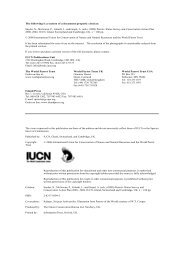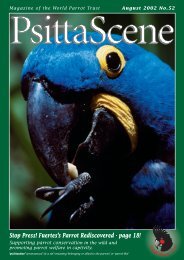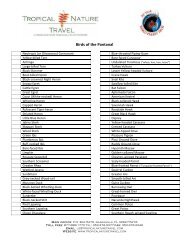PS 20 1 Feb 08.qxd - World Parrot Trust
PS 20 1 Feb 08.qxd - World Parrot Trust
PS 20 1 Feb 08.qxd - World Parrot Trust
You also want an ePaper? Increase the reach of your titles
YUMPU automatically turns print PDFs into web optimized ePapers that Google loves.
RIGHT Chicks are weighed and<br />
measurements are taken of the tarsus,<br />
wing, and head regularly until fledging.<br />
Feather development is also carefully<br />
tracked. These data helps researchers<br />
understand how the wild chicks develop.<br />
LOWER LEFT Newly hatched nestlings are<br />
very small and featherless. When trying to<br />
take measurements its hard to get over<br />
how delicate they seem!<br />
LOWER RIGHT Fieldwork can be fun and<br />
interesting but it is not glamorous. While<br />
monitoring parental behaviour and<br />
breeding biology, researchers spend long<br />
hours recording all observations at a nest.<br />
Photo: © Soledad Díaz<br />
Conservation Issues<br />
The Austral Conure is currently included in<br />
Appendix II of CITES and is considered of low<br />
concern in Chile and Argentina, in both cases<br />
with a zero extraction value (trade not allowed).<br />
But due in part to the lack of studies on this<br />
species, its conservation status is uncertain. The<br />
notion that it is "abundant" because large noisy<br />
flocks are observed during austral winters<br />
around urbanized sites may be misleading, since<br />
the actual status of most populations is<br />
unknown.<br />
Until now, this species was only known to be<br />
affected by habitat loss (forest loss and<br />
fragmentation), while the live bird trade was<br />
considered of minor impact. However, over the<br />
course of our studies we found a growing<br />
interest in this species as a pet, both at a local<br />
and at a distribution-wide scale.<br />
Photo: © Laura Chazarreta<br />
Causes for concern<br />
Austral Conure are potentially vulnerable during<br />
the reproductive season. They require very large<br />
trees to accommodate nesting cavities and<br />
depend on food sources close to their nesting<br />
sites. This leads us to propose that Austral<br />
Conures are dependent on rather continuous<br />
mature native forests for breeding purposes. As<br />
with other regions of the world, forestry<br />
operations are rapidly expanding towards the<br />
southern temperate forests, with logging projects<br />
extending throughout Chile and Argentina at an<br />
increased rate.<br />
Moreover, this species is now being persecuted<br />
and hunted during winter, when large flocks<br />
gather around villages and urbanized sites. We<br />
have witnessed people (mostly children) hunting<br />
the conures with slings when they perch and<br />
forage in small groups of trees. As a result,<br />
many birds are injured or killed and others are<br />
caught and sold at a very low price (about US<br />
$3). Once we were aware of this problem, we<br />
contacted the authorities. Surprisingly, we found<br />
a total lack of enforcement. This may be an<br />
emerging problem that was not part of the<br />
agenda of the official wildlife management<br />
agencies in the past. Unfortunately, we found<br />
that owls and other wildlife faced the same<br />
problem in urban areas. In this respect, both<br />
supervision of human activities and education<br />
programs seem fundamental to stop this<br />
negative attitude against wildlife from spreading.<br />
We suggest it is time to initiate conservation<br />
programs directed at the Austral Conure before<br />
they become more popular in the live bird trade<br />
culture, which, along with habitat loss, may result<br />
in the species becoming endangered within the<br />
next 10 years.<br />
Soledad Díaz & Valeria Ojeda: Laboratorio<br />
Ecotono. Departamento de Ecologia.<br />
Universidad Nacional del Comahue, 8400.<br />
Bariloche. Argentina. jisdiaz@yahoo.com.ar<br />
Photo: © Valeria Ojeda<br />
<strong>Feb</strong>ruary <strong>20</strong>08 PsittaScene 13




